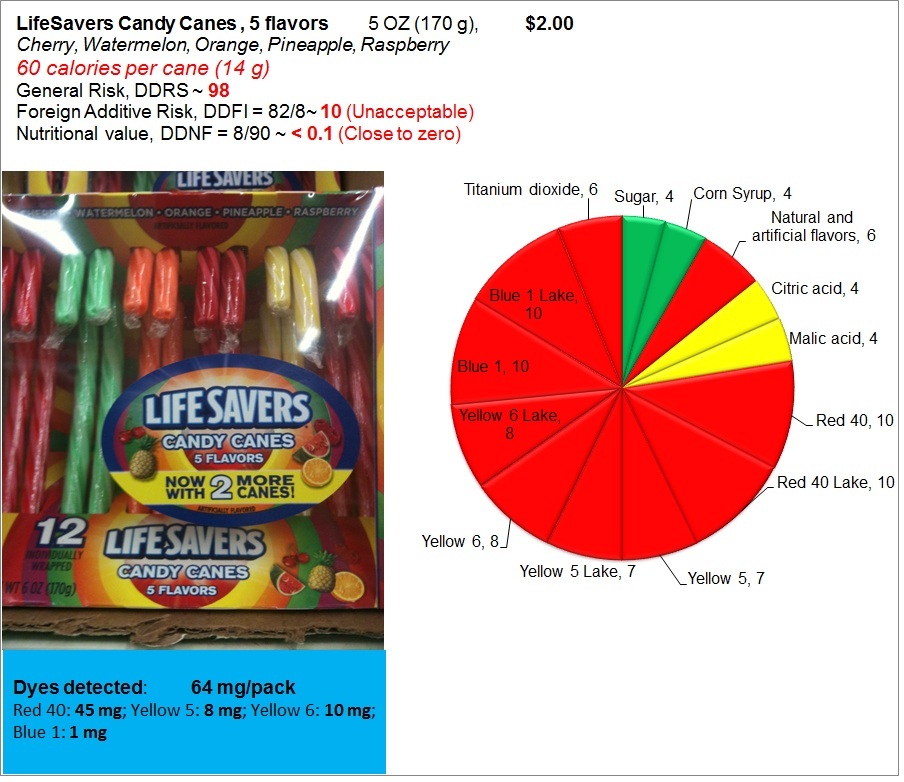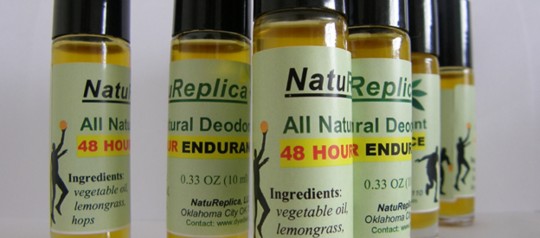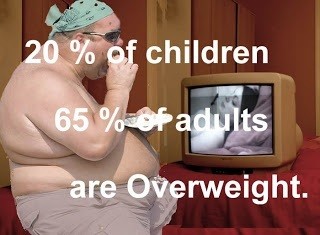Artificial Colors of Candy Canes
Christmas should be the time when everyone makes another effort towards truth, peace and moral cleanliness. Not so for the candy makers. Those keep thinking more about how much they will profit from deceiving you and your kids. Made in Mexico, Life Savers Candy Canes look more like “Life Wasters” to me. While the container is decorated with colorful pictures of beautiful fruits all the colors of the candy canes come from synthetic azo dyes (red and yellow strips), aniline dye (green strips) and titanium dioxide (white strips). Titanium dioxide is possibly carcinogenic for humans when inhaled as dust (see PDF file IARC Monographs on the Evaluation of Carcinogenic Risks to Humans). So why, why take the chances?
DyeDiet Doesn’t Buy It!
The DyeDiet risk diagram is almost all red. Due to 9 artificial colorants and artificial flavors your risks are unacceptably high, DDFI = 82/8 ~ 10 and the nutritional value is close to zero: DDNF = 8/90 ~ <0.1. Of course, candy implies plenty of sugar, nothing wrong with that. But what I do not buy is those bio-chemically foreign synthetic colorants and flavors deliberately added under the pretension that the candy canes have something to do with the fruits: cherry, watermelon, orange, pineapple and raspberry. Yes, it says “artificially flavored” but what this supposed to mean? Does this means that the fruits are artificially flavored or that there are no fruits at all? Make no mistake, the latter is the case. The ingredient list tells us that the candy is merely artificially flavored and colored sugar:
- Sugar
- Corn syrup
- Artificial colors, flavors and preservatives.
In the Internet you can find something like this: “Every time you see a Candy Cane, remember the Wonder of Jesus and His Great Love that come down at Christmas, and that His Love remains the ultimate and dominant force in the universe today.” Well, it would be so if the candies were not deliberately poisoned with the toxins and lies. I can imagine how Jesus would spit these “life savers” out if the candy makers dared to offer them to Him.
Food manufacturers have a choice to go with natural food coloring but they choose to feed you and your children with the cheap petroleum derived chemicals. While natural colorants are not perfectly safe and may cause allergies the very fact of their occurrence in the nature suggests that they are edible at least by some living species and organisms. The synthetic colorants are not. Yes, the amounts of the azo dyes added are way lower than their median lethal dose (LD50), the amount required to kill a half of the exposed organisms or… children. Thanks to the food manufacturers for letting us to stay alive! But what we talking about here are unknown long term health effects caused by chronic exposure to so many synthetic, biologically foreign food additives, food dyes included. Who knows what Red 40 does to your child when 7 mg of it consumed with every “cherry”, “watermelon” and “raspberry” candy cane? Who knows, if 5 mg of Yellow 6 will make a little damage to your child’s DNA when swallowed with every “orange” candy cane? Or who can guarantee that 0.5 mg of the aniline dye Blue 1, capable of crossing blood-brain barrier, and 1.5 mg of Tartrazine (Yellow 5) eaten with every “pineapple” candy cane do not destroy some brain neurons? While exact mechanisms of the damage are yet to be uncovered there is a long history of reporting of adverse effects of the dyes on human and animal health, including cancers (read the CSPI report: Food Dyes: A Rainbow of Risks), psychiatric disorder (read Diet, ADHD and Behavior) and allergies. Please watch this video from Feingold Association Many learning and behavior problems begin in your grocery cart! In the extreme cases feeding with Blue 1 dyed food may cause blue colored colon discovered postmortem, at autopsy (See Blue colon at autopsy).
So, every time you see a Candy Cane, remember that it may be damaging for your health which is NOT what Jesus wants for you! Hope this report helps you to make less risky food choices. Have a Healthy Merry Christmas!
Category: Candy, Candy and snacks, Food Dyes Exposure








